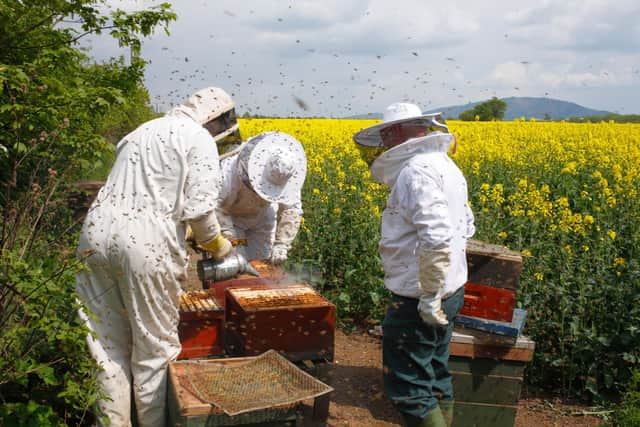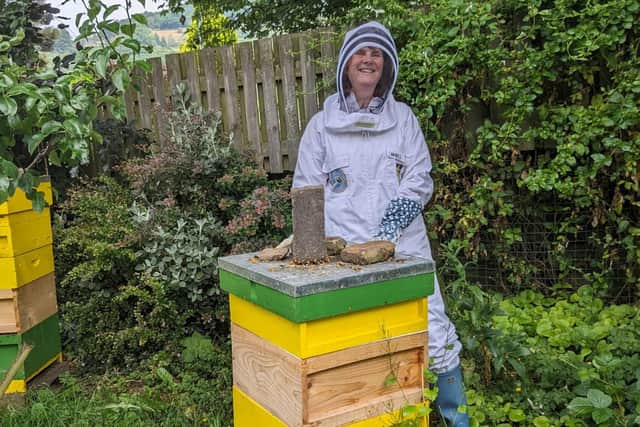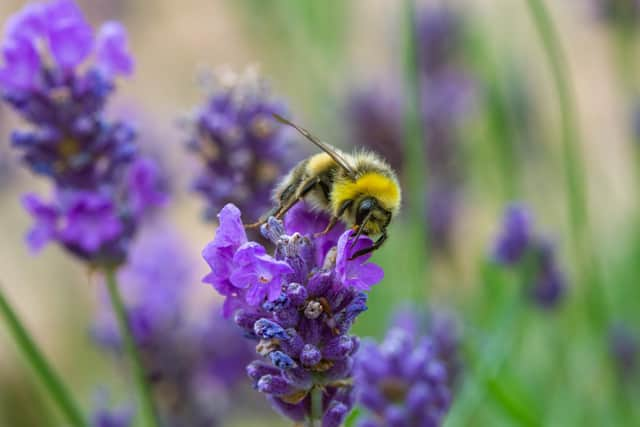Holmfirth beekeeper's advice as TikTok users take an interest in the honey hive
But with people setting up hives on their balconies, honey being made up and down the country and a whopping 1.9 billion TikTok views for #beekeeping, it might now be the busiest time for starting a buzzy new hobby.
“People generally have a fear of bees, I did when I started,” says Caroline. “Looking at frames of thousands of bees was a bit frightening, but it’s something you get used to, and it becomes so inspirational and enjoyable.
Advertisement
Hide AdAdvertisement
Hide AdBut, how do you get started? First of all, you need a place to put them.


Caroline, 61, says: “I used to be a volunteer at our local high school on gardening projects. I was offered a short course and we got bees in the school, but it didn’t work out, so I acquired a beehive. They are in my garden and three other ladies come and help me,” she explains.
But, if you don’t have a garden, Ingham says you can put them on roofs and balconies, as long as you seek the right permissions and tell your neighbours.
Many, though, may be put off not only by the cost, but the obvious fear of getting stung.
Advertisement
Hide AdAdvertisement
Hide Ad“You need a proper bee suit – full length with gloves and protective footwear, even wellies,” she continues. “It can be expensive, depending on what lengths you go to and the equipment you acquire. If you join an association, you can find stuff relatively cheaply – and it doesn’t have to be new.


“If you were to shop online from new, it would cost about £500. More carefully, it could cost £250.”
But, what about the actual hives? “Basic equipment would be a hive, and here in the UK, we tend to go for a national type, with frames and a foundation, with a small number of tools for lifting the frames,” Ingham explains.
Organisations may be able to help source items, says Caroline.
Advertisement
Hide AdAdvertisement
Hide Ad“There are British beekeeping associations for each district, I am part of the Huddersfield Beekeeping Association. As a member, you get insurance if there is a problem with the hive. Joining the association is around £35 annually.”


So, you have the gear, but where do you actually get the bees from? Well, associations may be able to help you find someone selling a hive, or someone looking to redirect a swarm.
“This year has been a big year for swarming, but you can pre-empt them (a swarm is a queen leaving the hive and taking some of the bees with her). If you witness the bees making queen cells protruding on the foundation, it will indicate they are not happy, so they are making a new one,” Ingham explains.
What should you be worried about?
“Winter is a bad time to get the bees through – it depends so much on the weather. They don’t come out of the hive until it is about 13 degrees, and in the winter, you need to insulate them,” says Ingham.
Advertisement
Hide AdAdvertisement
Hide Ad“You also have to do treatments for insects they can be prone to, and making sure you do regular inspections of your hives is really important.”
While Holmfirth, famous for being the home of Last of the Summer Wine, seems a fitting place for such activities, beekeeping is happening in urban areas too.
Last year, The Yorkshire Post featured Bill Cadmore, who told us about the high demand for courses he helps run with the Bradford Beekeepers Association.
In 2009 he set up an apiary at Wellington Place in Leeds. Over the years, as development of the site continued, his apiary was relocated to the nearby riverbank.
Advertisement
Hide AdAdvertisement
Hide AdEventually he started to put on beekeeping classes for office workers at lunchtimes. Groups don bee-suits to participate in hands-on sessions held during the summer months, when there are around 350,000 bees on site.
“Urban beekeeping offers people a rewarding chance to connect with nature, and contribute to conserving our pollinator pals in urban settings,” says Amanda John, a professional beekeeper who works closely with the brand Rowse Honey.
“This form of beekeeping has become increasingly popular, as the importance of protecting our bees becomes more prevalent.”
However, she adds: “When getting started in urban beekeeping, it is essential to understand the safety and basic knowledge of beekeeping.”
Advertisement
Hide AdAdvertisement
Hide Ad“If possible, this means attending beekeeping workshops – which can be booked online – and connecting with local beekeepers to learn more about bee behaviour, hive management and safety protocols. Understanding these basics is the key to success.”
While it isn’t easy, it is rewarding, for both you and the planet.